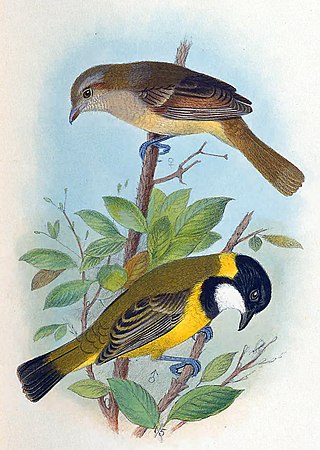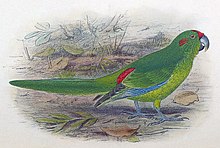
The morepork, also called the mopoke or the ruru, is a small brown owl found in New Zealand, Norfolk Island and formerly Lord Howe Island. The bird has almost 20 alternative common names, including mopoke and boobook—many of these names are onomatopoeic, as they emulate the bird's distinctive two-pitched call. Three subspecies of the morepork are recognized, one of which is extinct and another that exists only as a hybrid population.

Platycercinae is a subfamily of birds belonging to the family Psittaculidae that inhabit Oceania. It consists of two tribes, the ground parrots and allies (Pezoporini) and the many species of broad-tailed parrot (Platycercini).

A broad-tailed parrot is any of about 35–40 species belonging to the tribe Platycercini. The members of the tribe are small to medium in size, and all are native to Australasia, Australia in particular, but also New Zealand, New Caledonia, and nearby islands.

Cyanoramphus is a genus of parakeets native to New Zealand and islands of the southern Pacific Ocean. The New Zealand species are often called kākāriki. They are small to medium-sized parakeets with long tails and predominantly green plumage. Most species are forest dwellers, although several of the subantarctic species live in open grassland. The genus formerly had a widely disjunct distribution: while most of the genus ranged from New Caledonia to Macquarie Island, two species were found in the Society Islands, 4,100 km (2,500 mi) away from the rest. Although the islands between these two areas have yielded many bird fossils, undescribed extinct Cyanoramphus have not yet been found on any of them.

The crimson rosella is a parrot native to eastern and south eastern Australia which has been introduced to New Zealand and Norfolk Island. It is commonly found in, but not restricted to, mountain forests and gardens. The species as it now stands has subsumed two former separate species, the yellow rosella and the Adelaide rosella. Molecular studies show one of the three red-coloured races, P. e. nigrescens, is genetically more distinct.

The Seychelles parakeet or Seychelles Island parrot is an extinct species of parrot that was endemic to the Seychelles in the Indian Ocean. It was scientifically named Palaeornis wardi by the British ornithologist Edward Newton in 1867, and the specific name honours the British civil commissioner Swinburne Ward who procured the specimens that formed the basis for the description. It was found on the islands of Mahé, Silhouette, and possibly Praslin. Ten skin specimens exist today, but no skeletons. Though the species was later moved to the genus Psittacula, genetic studies have led some researchers to suggest it should belong in a reinstated Palaeornis along with the closely related Alexandrine parakeet (P. eupatria) of Asia.

The red-crowned parakeet, also known as red-fronted parakeet and by its Māori name of kākāriki, is a small parrot from New Zealand. It is characterised by its bright green plumage and the red pattern on its head. This versatile bird can feed on a variety food items and can be found in many habitat types. It used to be classified as near threatened as invasive predators had pushed it out of its historical range but it is now at least concern. This species used to occupy the entire island, but is now confined to only a few areas on the mainland and some offshore islands.

The turquoise parrot is a species of parrot in the genus Neophema native to Eastern Australia, from southeastern Queensland, through New South Wales and into North-Eastern Victoria. It was described by George Shaw in 1792. A small lightly built parrot at around 20 cm (7.9 in) long and 40 g in weight, it exhibits sexual dimorphism. The male is predominantly green with more yellowish underparts and a bright turquoise blue face. Its wings are predominantly blue with red shoulders. The female is generally duller and paler, with a pale green breast and yellow belly, and lacks the red wing patch.

The Chatham parakeet, also known as Forbes' parakeet, is a rare parakeet endemic to the Chatham Islands group, New Zealand. This parakeet is one of New Zealand's rarest birds and is classified as Vulnerable on the IUCN Red List, as a result of a range of threats to the species survival, including habitat loss, predation, and hybridization. A number of conservation methods have been employed to assist the recovery of this species, and currently the population trend is considered stable.

The Norfolk parakeet, also called Tasman parakeet, Norfolk Island green parrot or Norfolk Island red-crowned parakeet, is a species of parrot in the family Psittaculidae. It is endemic to Norfolk Island.

The golden monarch is a species of passerine bird in the family Monarchidae found in New Guinea. Its natural habitats are subtropical or tropical moist lowland forests and subtropical or tropical moist montane forest. The golden monarch displays marked sexual dimorphism, the male a striking golden colour with black mask, wings and tail, the female a golden or golden-olive colour. Both bear a characteristic 'teardrop' white pattern below the eye.

The Arafura fantail, sometimes known as the wood fantail, inhabits the Lesser Sunda Islands, the northern coast of Australia from the Kimberley to the western side of the Cape York Peninsula, including subcoastally in the Top End of the Northern Territory, and southern New Guinea. It is similar to the rufous fantail, from which it has been split taxonomically but, apart from minor overlap in the eastern Moluccas, their geographic ranges are discrete. It is generally duller than the rufous fantail with the rufous colouration more restricted.

The Lord Howe fantail, also known as the Lord Howe Island fantail or fawn-breasted fantail, was a small bird in the fantail family, Rhipiduridae. It is an extinct subspecies of the New Zealand fantail. It was endemic to Lord Howe Island in the Tasman Sea, part of New South Wales, Australia.

The Lord Howe boobook, also known as the Lord Howe morepork, was a bird in the true owl family endemic to Lord Howe Island in the Tasman Sea, part of New South Wales, Australia. It is an extinct and little-known subspecies of the morepork.

The Lord Howe currawong, Lord Howe Island currawong or Lord Howe pied currawong, is a large and mainly black passerine bird in the family Artamidae. It is endemic to Lord Howe Island in the Tasman Sea, part of New South Wales, Australia, and is a threatened subspecies of the pied currawong.

The Lord Howe golden whistler, also known as the Lord Howe whistler or Lord Howe Island golden whistler, and locally as the “robin” or “yellow robin”, is a small bird in the whistler family, Pachycephalidae. It is a subspecies of the Australian golden whistler that is endemic to Lord Howe Island in the Tasman Sea, part of New South Wales, Australia.

The Christmas goshawk or Christmas Island goshawk, is a bird of prey in the goshawk and sparrowhawk family Accipitridae. It is a threatened endemic of Christmas Island, an Australian territory in the eastern Indian Ocean.
The Christmas Island swiftlet, also known as the Christmas glossy swiftlet or the Christmas cave swiftlet, is a small bird in the swift family Apodidae. It is endemic to Christmas Island, an Australian territory in the eastern Indian Ocean. It was formerly commonly treated as a subspecies of the glossy swiftlet.
Leslie Christidis, also simply known as Les Christidis, is an Australian ornithologist. His main research field is the evolution and systematics of birds. He has been director of Southern Cross University National Marine Science Centre since 2009. He was assistant director at Sydney's Australian Museum from 2004 to 2009.

The Kermadec red-crowned parakeet, also known as the Kermadec red-fronted parakeet or Kermadec parakeet, is a parrot endemic to New Zealand's Kermadec Islands in the south-west Pacific Ocean. It is a subspecies of the red-fronted parakeet, and sometimes considered a full species. It is also the first documented example of a parrot recolonising an island after the removal of invasive predators.




















